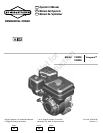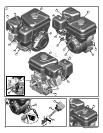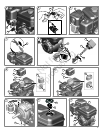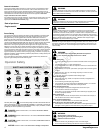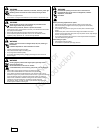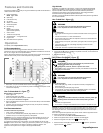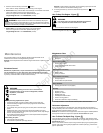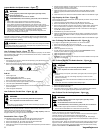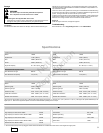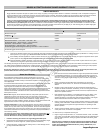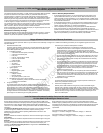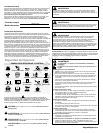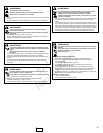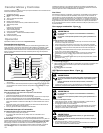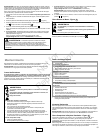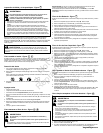
8
VanguardEngines.com
Inspect Muffler And Spark Arrester - Figure
6
Running engines produce heat. Engine parts, especially muffler,
become extremely hot.
Severe thermal burns can occur on contact.
Combustible debris, such as leaves, grass, brush, etc. can catch fire.
WARNING
Allow muffler, engine cylinder and fins to cool before touching.
Remove accumulated debris from muffler area and cylinder area.
It is a violation of California Public Resource Code, Section 4442, to use or
operate theengine onany forest-covered, brush-covered,or grass-covered land
unless the exhaust system is equipped with a spark arrester, as defined in
Section 4442, maintained in effective working order. Other states or federal
jurisdictions may have similar laws. Contact the original equipment
manufacturer, retailer, or dealer to obtain a spark arrester designed for the
exhaust system installed on this engine.
Remove accumulated debris from muffler area and cylinder area. Inspect the muffler (A,
Figure 6) for cracks, corrosion, or other damage. Remove the spark arrester (B), if
equipped, and inspect for damage or carbon blockage. If damage is found, install
replacement parts before operating.
WARNING: Replacement parts must be ofthe same design and installed
in the same position as the original parts. Other parts may not perform as well, may
damage the unit, and may result in injury.
How To Change The Oil - Figure
7 8
Used oil is a hazardous waste product and must be disposed of properly. Do not discard
with householdwaste. Check with your localauthorities, servicecenter, ordealer forsafe
disposal/ recycling facilities.
Remove Oil
1. With engine off but still warm, disconnect the spark plug wire (A) and keep it away
from the spark plug (Figure 7).
2. Remove the oil drain plug (B, Figure 8). Drain the oil into an approved receptacle.
Note: Any of the oil drain plugs shown below may be installed in the engine.
3. After the oil has drained, install and tighten the oil drain plug.
Add oil
Place engine level.
Clean the oil fill area of any debris.
See the Specifications section for oil capacity.
1. Remove the dipstick (D) and wipe with a clean cloth.
2. Pour the oil slowly into the engine oil fill (E). Fill to point of overflowing.
3. Insert the dipstick. Do not turn or tighten.
4. Remove thedipstick andcheck the oillevel. Itshould be at thetop of the fullindicator
(F) on the dipstick.
5. Install and tighten the dipstick.
How To Service The Air Filter - Figure
9 10
WARNING
Fuel and its vapors are extremely flammable and explosive.
Fire or explosion can cause severe burns or death.
Never start or run the engine with the air cleaner assembly (if equipped) or the
air filter (if equipped) removed.
NOTICE: Do not use pressurized air or solvents to clean the filter. Pressurized air can
damage the filter and solvents will dissolve the filter.
Two types of air filter systems are shown, a Standard and a High Capacity. Determine
the type installed on your engine and service as follows.
Standard Air Filter - Figure
9
The standard air filter uses a foam element that can be washed and reused.
1. Loosen the fastener (A) that holds the cover (B). Remove the cover.
2. Remove the fastener (C), the washer (D), and the foam element (E).
3. Remove the support cup (F) from the foam element.
4. Wash thefoam element inliquid detergent and water. Squeeze dry the foam element
in a clean cloth.
5. Saturate the foam element with clean engine oil. To remove the excess engine oil,
squeeze the foam element in a clean cloth.
6. Insert the support cup into the foam element.
7. Install the foam element into the base (G) and onto stud (H). Make sure foam
element is properly assembled into base and secure with the washer and the
fastener.
8. Install the airfilter coverand secure withthe fastener. Make sure thefastener istight.
High Capacity Air Filter - Figure
10
The air cleanersystem uses a pleated filterwith an optionalpre-cleaner. Thepre-cleaner
can be washed and reused.
1. Loosen the fastener (A) that holds the cover (B). Remove the cover.
2. Remove the fastener (C), the pre-cleaner (D), if equipped, and the filter (E).
3. Remove the pre-cleaner, if equipped, from the filter. To loosen debris, gently tap the
filter on a hard surface. If the filter is excessively dirty, replace with a new filter.
4. Wash the pre-cleaner in liquid detergent and water. Then allow it to thoroughly air
dry. Do not oil the pre-cleaner.
5. Assemble the dry pre-cleaner to the filter.
6. Install the seal washer (F), the filter, and the pre-cleaner, if equipped, into the base
(G) and onto stud (H). Make sure filter is properly assembled into base and secure
with the fastener.
7. Install the airfilter coverand secure withthe fastener. Make sure thefastener istight.
How To Change The Gear Reduction Oil - Figure
11
If your engine is equipped with a gear reduction unit, service as follows.
1. Remove the oil fill plug (B) and the oil level plug (C).
2. Remove the oil drain plug (A, Figure 1 1) and drain the oil into an appropriate
receptacle.
3. Install and tighten the oil drain plug.
4. To refill, slowly pour gear lube into the oil fill hole (see Specifications section).
Continue to pour until the oil runs out of the oil level hole.
5. Install and tighten the oil level plug.
6. Install and tighten the oil fill plug.
Important: The oil fillplug has avent hole (D) andmust be installedon the topof the
gear case cover as shown.
How To Clean/Replace The Debris Strainer - Figure
12
WARNING
Fuel and its vapors are extremely flammable and explosive.
Fire or explosion can cause severe burns or death.
Keepfuel awayfromsparks, openflames,pilotlights, heat,andother ignition
sources.
Check fuellines, tank, cap, andfittings frequently forcracks or leaks.
Replace ifnecessary.
Replacement parts must be the same and installed in the same position as the
original parts.
If fuel spills, wait until it evaporates before starting engine.
1. Remove the fuel cap (A, Figure 12).
2. Remove the debris strainer (B).
3. If the debris strainer is dirty, clean or replace it. If you replace the debris strainer,
make sure to use an original equipment replacement debris strainer.
How To Clean The Air Cooling System - Figure
13
Running engines produce heat. Engine parts, especially muffler,
become extremely hot.
Severe thermal burns can occur on contact.
Combustible debris, such as leaves, grass, brush, etc. can catch fire.
WARNING
Allow muffler, engine cylinder and fins to cool before touching.
Remove accumulated debris from muffler area and cylinder area.
NOTICE: Do not use water to clean the engine. Water could contaminate the fuel
system. Use a brush or dry cloth to cleanthe engine.
This is an air cooled engine. Dirt or debris can restrict air flow and cause the engine to
overheat, resulting in poor performance and reduced engine life.
Use a brush or dry cloth to remove debris from the finger guard (A). Keep linkage,
springs and controls (B) clean. Keep the area around and behind the muffler (C)freeof
any combustible debris (Figure 13).
After a period of time, debris can accumulate in the cylinder cooling fins and cause the
engine to overheat. This debris cannot be removed without partial disassembly of the
engine. Have a Briggs & Stratton Authorized Dealer inspect and clean the air cooling
system as recommended in the Maintenance Chart.
Not for
Reproduction



